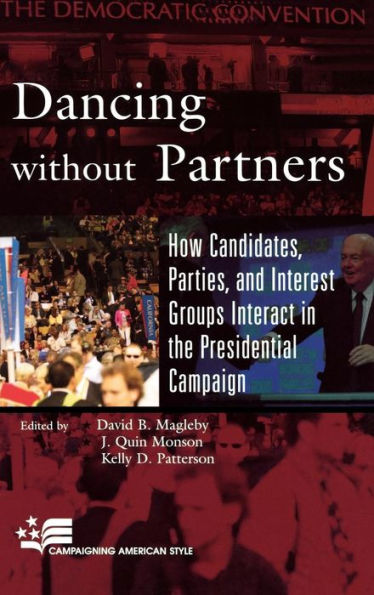Dancing without Partners: How Candidates, Parties, and Interest Groups Interact in the Presidential Campaign
Political parties, interest groups, and candidate campaigns all pursue similar goals in presidential elections: each entity attempts to mobilize voters. However, the regulatory environment often prevents these groups from coordinating their efforts. With participants playing by new rules mandated by the Bipartisan Campaign Reform Act, the 2004 presidential election included previously unseen configurations and alliances between political actors. In some campaign situations, the resulting "dance" was carefully choreographed. In others, dancers stepped on each other's toes. In still others, participants could only eye each other across the floor.
Dancing without Partners intensively analyzes the relationships among candidates, political parties, and interest groups under the BCRA's new regulations in the 2004 election cycle in five battleground states. The chapters assess the ways in which the rules of the game have changed the game itself—and also how they haven't. The result is a book that will be invaluable to researchers and students of presidential elections.
1147613102
Dancing without Partners intensively analyzes the relationships among candidates, political parties, and interest groups under the BCRA's new regulations in the 2004 election cycle in five battleground states. The chapters assess the ways in which the rules of the game have changed the game itself—and also how they haven't. The result is a book that will be invaluable to researchers and students of presidential elections.
Dancing without Partners: How Candidates, Parties, and Interest Groups Interact in the Presidential Campaign
Political parties, interest groups, and candidate campaigns all pursue similar goals in presidential elections: each entity attempts to mobilize voters. However, the regulatory environment often prevents these groups from coordinating their efforts. With participants playing by new rules mandated by the Bipartisan Campaign Reform Act, the 2004 presidential election included previously unseen configurations and alliances between political actors. In some campaign situations, the resulting "dance" was carefully choreographed. In others, dancers stepped on each other's toes. In still others, participants could only eye each other across the floor.
Dancing without Partners intensively analyzes the relationships among candidates, political parties, and interest groups under the BCRA's new regulations in the 2004 election cycle in five battleground states. The chapters assess the ways in which the rules of the game have changed the game itself—and also how they haven't. The result is a book that will be invaluable to researchers and students of presidential elections.
Dancing without Partners intensively analyzes the relationships among candidates, political parties, and interest groups under the BCRA's new regulations in the 2004 election cycle in five battleground states. The chapters assess the ways in which the rules of the game have changed the game itself—and also how they haven't. The result is a book that will be invaluable to researchers and students of presidential elections.
137.0
In Stock
5
1

Dancing without Partners: How Candidates, Parties, and Interest Groups Interact in the Presidential Campaign
202
Dancing without Partners: How Candidates, Parties, and Interest Groups Interact in the Presidential Campaign
202
137.0
In Stock

Product Details
| ISBN-13: | 9780742553491 |
|---|---|
| Publisher: | Bloomsbury Academic |
| Publication date: | 07/24/2006 |
| Series: | Campaigning American Style |
| Pages: | 202 |
| Product dimensions: | 6.00(w) x 9.00(h) x 0.62(d) |
About the Author
From the B&N Reads Blog
